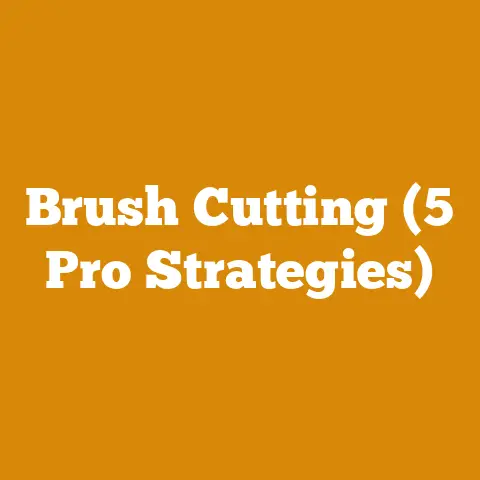Working Gear Boots (5 Rugged Picks)
Ever thought about how smart living isn’t just about gadgets and technology? For those of us who work with chainsaws, smart living is about having the right gear. And trust me, one of the most critical pieces of gear you can invest in is a good pair of working boots. Let me walk you through some of my top picks.
Why Boots Matter
Let’s chat about why boots are such a big deal. You might be thinking, “They’re just boots, right?” Nope, they’re your frontline defense against cuts, slips, and all sorts of woodland hazards. A solid pair can mean the difference between a productive day and a risky situation.
The Importance of Quality Footwear
You might wonder why there’s so much fuss about footwear. Well, in our line of work, it’s more than just about comfort. It’s about safety, efficiency, and durability. A quality pair of boots can prevent injuries from slipping or stepping on sharp objects and provide the necessary support to reduce fatigue after long hours in the field.
Personal Story: My First Chainsaw Job
I still remember my first job as a chainsaw operator. I was young and eager, with my shiny new chainsaw and an old pair of sneakers. That was a mistake I learned the hard way. A slip on wet leaves sent me sprawling, and I realized right then how crucial proper footwear is. Since then, boots have become as essential to me as my chainsaw.
My 5 Rugged Picks for Working Gear Boots
Here are five rugged picks that have stood out to me throughout the years.
1. Timberland PRO Boondock
I remember my first pair of Timberlands. They felt like tanks on my feet. These boots offer waterproof leather, anti-fatigue technology, and composite safety toes. Perfect for long days in unpredictable weather.
Features
- Waterproof Leather: Keeps your feet dry.
- Composite Safety Toes: Lightweight protection.
- Anti-Fatigue Technology: Reduces strain after long hours.
Personal Experience
I’ve worn these during some of the harshest weather conditions—rain, mud, snow—you name it. The waterproof feature is no joke; my feet stayed dry even when the rest of me was soaked.
Pros & Cons
Pros:
- Exceptional durability
- Comfort for prolonged use
Cons:
- Slightly heavier than other models
2. Chippewa Logger Boots
Got a soft spot for classic style? Chippewa Loggers might just be your thing. With their rugged leather and solid sole, they offer comfort without sacrificing durability.
Features
- Vibram Sole: Exceptional traction.
- Steel Toe: Safety without bulk.
- Goodyear Welt Construction: Enhances longevity.
Personal Experience
I wore these boots during a summer logging project. The Vibram soles provided fantastic grip on rocky terrain, making it easier to maneuver around without worrying about slipping.
Pros & Cons
Pros:
- Classic aesthetic
- Sturdy construction
Cons:
- Takes time to break in
3. Caterpillar Second Shift
Ever had those days when you’re scrambling over rocks and roots? Caterpillar’s Second Shift boots have got your back with sturdy soles and comfortable padding.
Features
- Slip Resistant: Great for uneven terrain.
- Climasphere Insole: Keeps your feet cool.
- Full-Grain Leather: Offers both comfort and durability.
Personal Experience
I took these boots on a week-long hiking trip that included some chainsaw work clearing trails. They offered great support without overheating my feet—a big plus in summer!
Pros & Cons
Pros:
- Affordable price point
- Comfortable for extended wear
Cons:
- May not be as durable as higher-end models
4. Danner Quarry USA
For those who value craftsmanship, Danner Quarry boots are handcrafted in the USA. They combine durability with comfort, offering a fit that feels like a glove.
Features
- Triple-Stitched: Added durability.
- GORE-TEX Lining: Breathable and waterproof.
- Electrical Hazard Protection: Built for safety.
Personal Experience
These boots have been my companions on several construction projects where safety was paramount. The fit was snug yet comfortable, which made it easy to focus on the task at hand instead of foot discomfort.
Pros & Cons
Pros:
- High-quality craftsmanship
- Excellent water resistance
Cons:
- Higher price range
5. Carhartt Rugged Flex
If flexibility is your thing, you can’t go wrong with Carhartt Rugged Flex boots. They bend just where you need them to without compromising on safety.
Features
- Rubber Outsole: Oil and slip resistant.
- FastDry Technology: Wicks away sweat.
- Flexible Design: Allows natural movement.
Personal Experience
These are perfect for those days when I need to switch between different tasks quickly. Whether I’m climbing ladders or operating heavy machinery, they adapt to every movement seamlessly.
Pros & Cons
Pros:
- Flexible yet supportive
- Great for various activities
Cons:
- Might not offer as much protection as steel-toe options
Choosing the Right Boot
So now that you’ve seen my favorites, how do you decide which one’s for you? Let’s dig into that with a few pointers.
Prerequisites & Required Knowledge
Before you buy, think about:
- Terrain: Where will you be working most often? Rocky? Muddy?
- Weather Conditions: Wet, dry, or snowy?
- Safety Standards: Do they meet necessary safety certifications?
- Foot Comfort: Do you have specific comfort needs or medical conditions?
Considerations for Terrain
Different terrains require different types of traction and support:
- Mud and Wet Areas: Look for deep treads and waterproofing.
- Rocky Terrain: Opt for solid soles with excellent grip.
- Flat, Dry Areas: Focus on comfort and breathability.
Evaluating Weather Conditions
Weather can affect your boot choice significantly:
- Rain and Snow: Waterproof materials are crucial.
- Hot Climates: Breathable fabrics will keep feet cool.
Safety Standards to Look For
Safety should never be compromised:
- Steel/Composite Toe: Protects against falling objects.
- Electrical Hazard Protection: Essential if working near live wires.
Custom Comfort Needs
If you have specific foot issues:
- Arch Support: Look for good insole support.
- Wide/Narrow Fit Options: Ensure proper sizing to avoid discomfort.
Safety Precautions
Always remember:
Check Fit Regularly
Misfitting boots can cause blisters or worse:
- Try them on with the socks you’ll wear at work.
- Walk around to ensure there’s no pinching or slipping.
Inspect Regularly
Look for signs of wear:
- Worn soles or damaged leather can reduce safety.
Clean Them
Prolong their life by maintaining them properly:
- Use suitable cleaning products for leather or synthetic materials.
Step-by-Step Boot Care
- Clean After Use: Remove dirt with a soft brush.
- Condition Leather: Use a leather conditioner regularly.
- Dry Properly: Avoid direct heat; let them air-dry.
- Store Well: Keep them in a cool, dry place away from sunlight.
Tips & Warnings
Tip: Always break in new boots before taking them out for a full day of work.
Warning: Never use damaged boots; they compromise safety.
Common Questions & Troubleshooting
Q: How do I know if my boots need replacement?
A: Look for worn soles, cracks in leather, or loss of waterproofing.
Q: My boots feel tight. Any quick fixes?
A: Use a boot stretcher or wear thick socks when breaking them in.
Wrapping Up and Next Steps
You’ve got the lowdown on what makes a great working boot and how to choose the right one for your needs. Remember, comfortable and safe feet make all the difference when you’re out there working hard.
FAQ
Q: Can I use regular hiking boots for chainsaw work?
A: It’s best to use boots specifically designed for chainsaw work due to added safety features.
Q: How often should I replace my work boots?
A: Depending on use, typically every 6 to 12 months or when they show significant wear.
Q: Are steel-toe boots always better?
A: It depends on your needs. Composite toes offer lighter alternatives without sacrificing protection.
Happy sawing, and stay safe out there!






